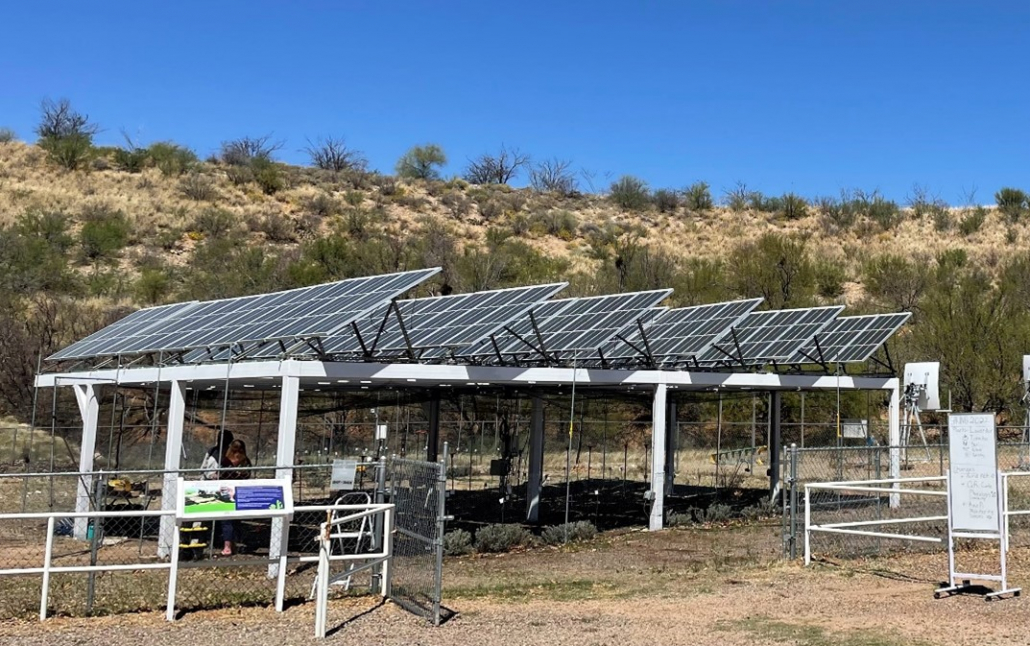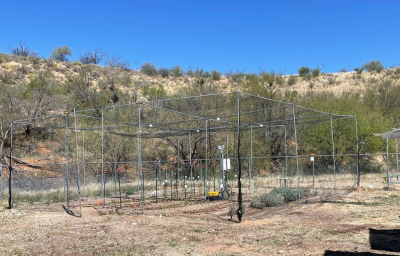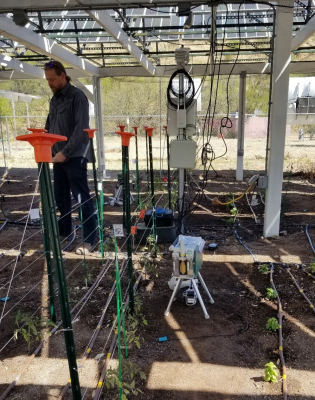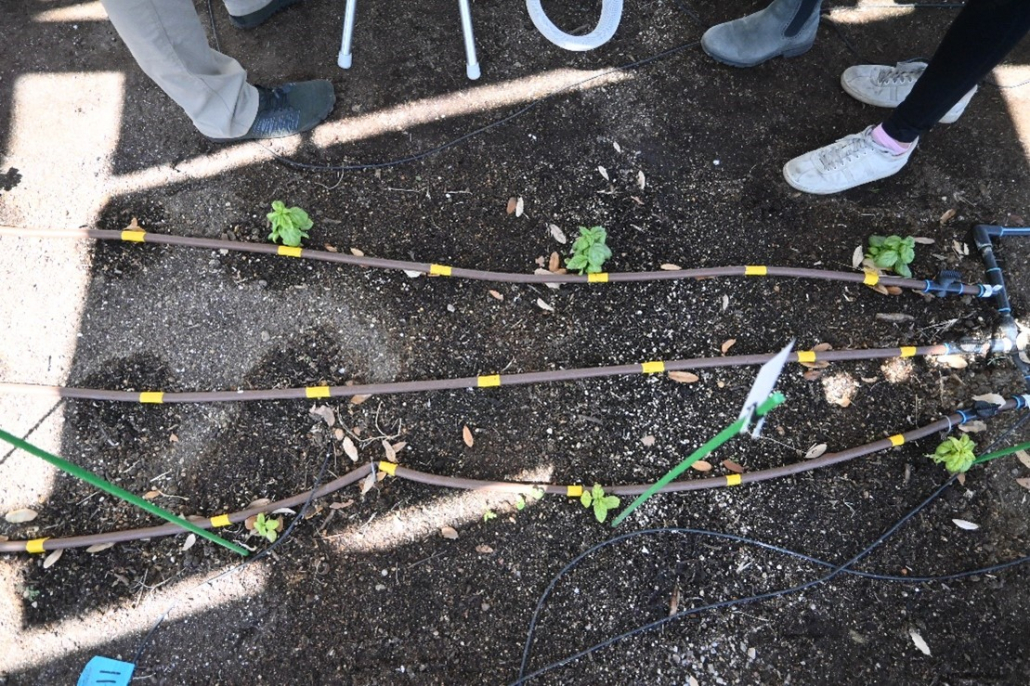Biosphere 2, located in Oracle, Arizona, houses one of the first agrivoltaic research sites in the United States. The site was built seven years ago with a 21.6-kW solar PV array shading a 9×18-meter garden. Greg Barron-Gafford, along with several graduate students, use this garden to study the changes in phenology of several varieties of vegetables and fruit, soil health, panel production, water consumption, and carbon scrubbing that are affected by the shading of the solar array. A control area of the same size with no shading was built within 10 feet of the solar garden for comparison. The fruits and vegetables grown here are tomatoes, caribe potatoes, butternut squash, red beans, bok choy, and basil.

Harvested food grown in the solar garden at Biosphere 2. Photo: Mariah Rogers, University of Arizona
Phenology, the study of the relationship between climate and plant life production and health, is a main focus at Biosphere 2. Graduate students are studying the timing of fruiting and/or flowering, along with plants’ dying cycle, at the solar garden and comparing these results to the full-sun control site. They are currently working with the National Phenology Network to share and analyze data. Soil health is also monitored by testing the amount of carbon in the soil. This is a slower process, as it takes time for carbon, microbes, and other organics to develop in dryland areas such as Arizona.
The students test the greenhouse gas consumption or carbon-scrubbing abilities of the plants as the conditions change. They track photosynthesis of the plants grown beneath the panels versus those grown in the control area to see when and for how long photosynthesis is affected by the hot climate and the shade. Plants’ ability to carbon scrub decreases in hot conditions, which in turn affects their health and growth patterns. This research is showing that plants can maximize their ability to carbon scrub under the solar panels due to the shading and reduced heat seen in dryland agriculture.
The watering-treatment experiment tests the health and production of plants using two watering methods. Half of the plants are on a watering schedule based on what the plants in the control site need to flourish. The other half of test plants are watered half the time, therefore receiving half the water. Both watering schedules are used in the solar garden and control garden for comparison. These experiments are proving that shaded growing areas in dryland agriculture can use less irrigation water to grow crops if planted under a solar array.
Recently, these plants went through a blind taste test to see if there is any taste difference between the fruits and vegetables grown under solar versus under full sun. The main plants tested were tomatoes, beans, squash, and basil. Each plant group was harvested from both the control site and the solar site on the same day, washed the same, and presented the same. The study found that no significant taste difference was observed—good news for farmers worried about a change in flavor for their crops.
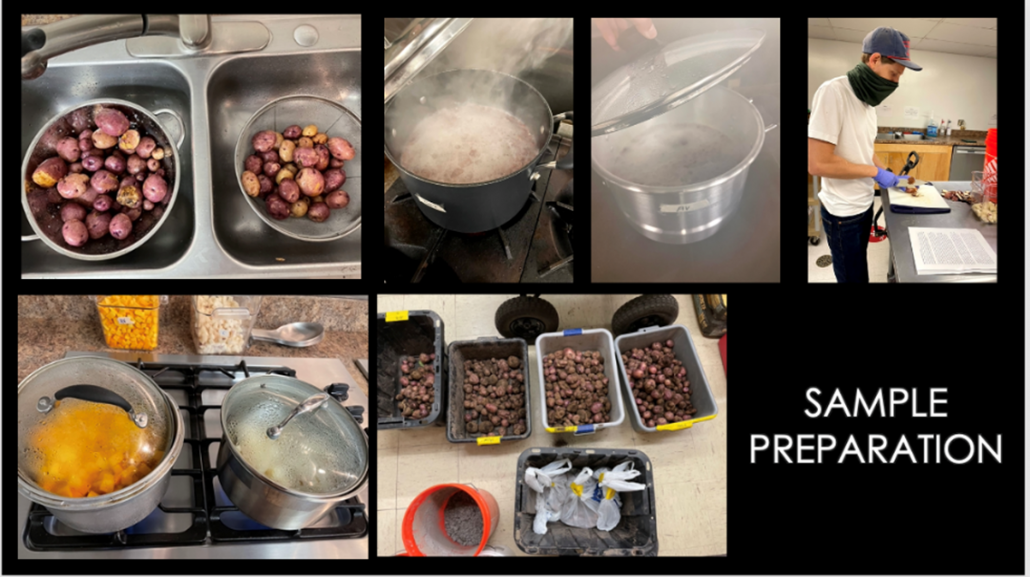
Sample preparation for the solar garden grown taste tests. Photo: Mariah Rogers, University of Arizona
The solar panel temperatures are being tested using thermocouples taped to the underside of the panels. Electricity flows easier in cooler conditions; thus, solar panels produce best when the underside of the panel stays under 75-80oF. The garden below creates a cooler environment for the panels than arrays with a gravel layout.
Graduate students are also testing a remote sensing system at the solar site using satellite imaging and remote monitoring to learn whether remote sensors and monitoring are effective in site monitoring. This technology will hopefully help with site monitoring from a distance when travelling is not an option.
Greg Barron-Gafford and his team of graduate students are making leaps and bounds in agrivoltaic farming research. They hope to educate farmers across dryland agriculture and beyond on the double benefits of growing under solar panels while also producing electricity. To learn more about this program please watch the video below and visit Greg’s website. https://www.barrongafford.org/agrivoltaics.html

